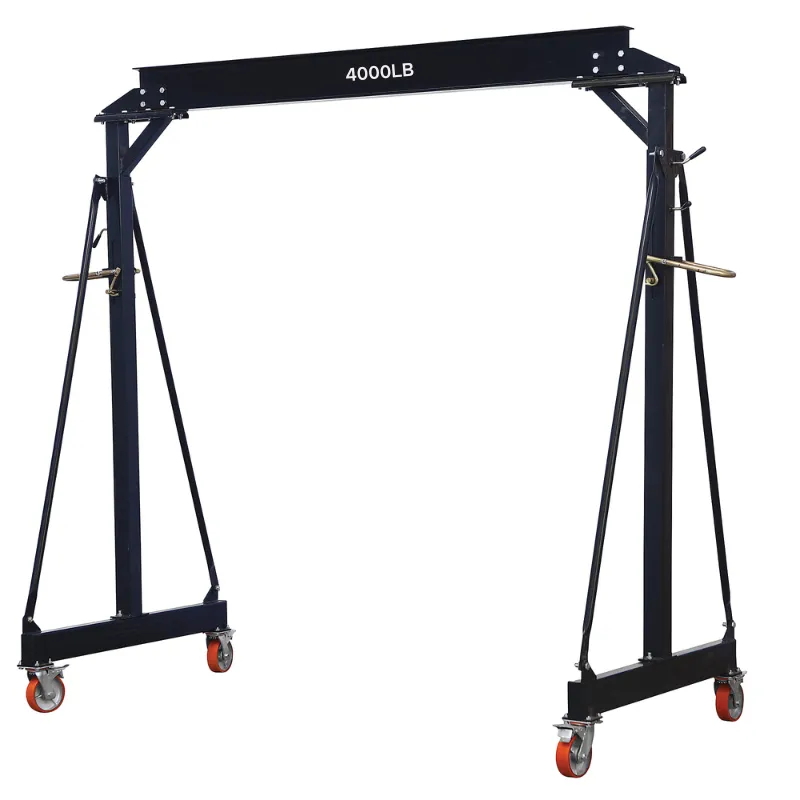crane gantry system
Understanding Crane Gantry Systems A Comprehensive Overview
Crane gantry systems play a crucial role in various industrial and construction applications, providing solutions for lifting and moving heavy materials with efficiency and precision. These systems, characterized by their distinctive A-frame structure, are designed to support a crane mechanism that can traverse horizontally along the rails mounted on the top of the frame. Understanding the components, advantages, and applications of crane gantry systems is essential for industries relying on heavy lifting operations.
Components of Crane Gantry Systems
A crane gantry system consists of several key components
1. Gantry Frame The primary structure of the system, typically made from steel or aluminum, provides stability and strength. The A-frame shape allows for balance and efficient weight distribution while supporting the crane.
2. Rails Mounted on the top of the gantry frame, rails provide a pathway for the crane’s movement. They are designed to endure the weight of the crane as well as any loads it carries.
3. Crane Mechanism This includes the hoist, trolley, and hook. The hoist is responsible for lifting the load vertically, while the trolley allows horizontal movement along the rails.
4. Support Wheels These wheels are positioned at the base of the gantry frame, facilitating smooth movement along the ground or track.
5. Power Supply Gantry cranes can be manually operated or powered by electricity, enabling automation and remote control for enhanced safety and efficiency.
Advantages of Crane Gantry Systems
Crane gantry systems offer several advantages that make them ideal for a wide range of applications
1. Versatility They can be used in various settings, including construction sites, warehouses, shipyards, and manufacturing plants. Their adaptable designs can accommodate different load sizes and weights.
2. Mobility Many gantry systems are portable, allowing them to be relocated easily as projects evolve. This mobility is particularly beneficial in construction environments where space and logistics play a significant role.
crane gantry system

3. Cost-Effectiveness Compared to traditional overhead cranes, gantry systems can be more affordable to install and maintain. They often require less infrastructure, making them a practical choice for smaller operations.
4. Safety With the right safety features, such as overload protection and emergency stop buttons, crane gantry systems enhance worker safety during lifting operations. Their design minimizes the potential for accidents, particularly in high-traffic areas.
5. Ease of Operation The intuitive controls and mobility features make crane gantry systems easy to operate, reducing the training time for new employees and streamlining workflow processes.
Applications of Crane Gantry Systems
The applications of crane gantry systems are extensive, addressing the needs of various industries
1. Construction In construction settings, gantry cranes are essential for lifting heavy materials like steel beams, concrete blocks, and prefabricated components, facilitating the construction process.
2. Manufacturing In manufacturing plants, gantry systems are used to move assemblies or carry out machining operations, increasing production efficiency.
3. Shipbuilding and Repair In marine settings, gantry cranes assist in launching, repairing, and storing ships, proving indispensable to shipyards.
4. Warehouse Management Gantry systems help in the organization of materials, enhancing inventory management by simplifying the loading and unloading process.
5. Movie and Stage Production In the entertainment industry, gantry systems are utilized for rigging and staging, allowing for seamless setup and adjustments during performances.
Conclusion
Crane gantry systems represent a perfect blend of innovation, efficiency, and safety in lifting and material handling. Their versatile designs and practical applications make them invaluable in numerous industries. With advancements in technology, the future of crane gantry systems looks promising, with potential improvements in automation, materials, and environmental sustainability. Understanding these systems not only aids industries in optimizing their operations but also highlights the importance of safety and efficiency in today’s fast-paced work environments.
-
Unlock Seamless Relocation with Our Heavy Equipment Moving ExpertiseNewsJun.06,2025
-
Unleash Unrivaled Flexibility with Our Adjustable Gantry CraneNewsJun.06,2025
-
Unleash Heavy-Duty Efficiency with Our Industrial Gantry Crane SolutionsNewsJun.06,2025
-
Revolutionize Steel Handling with Our Magnetic Lifter RangeNewsJun.06,2025
-
Master Equipment Mobility with Premium Machinery Mover SolutionsNewsJun.06,2025
-
Elevate Your Material Handling with Magnetic Lifter TechnologyNewsJun.06,2025
-
YS Permanent Lifting Magnets: The Smarter Way to Handle SteelNewsMay.22,2025
